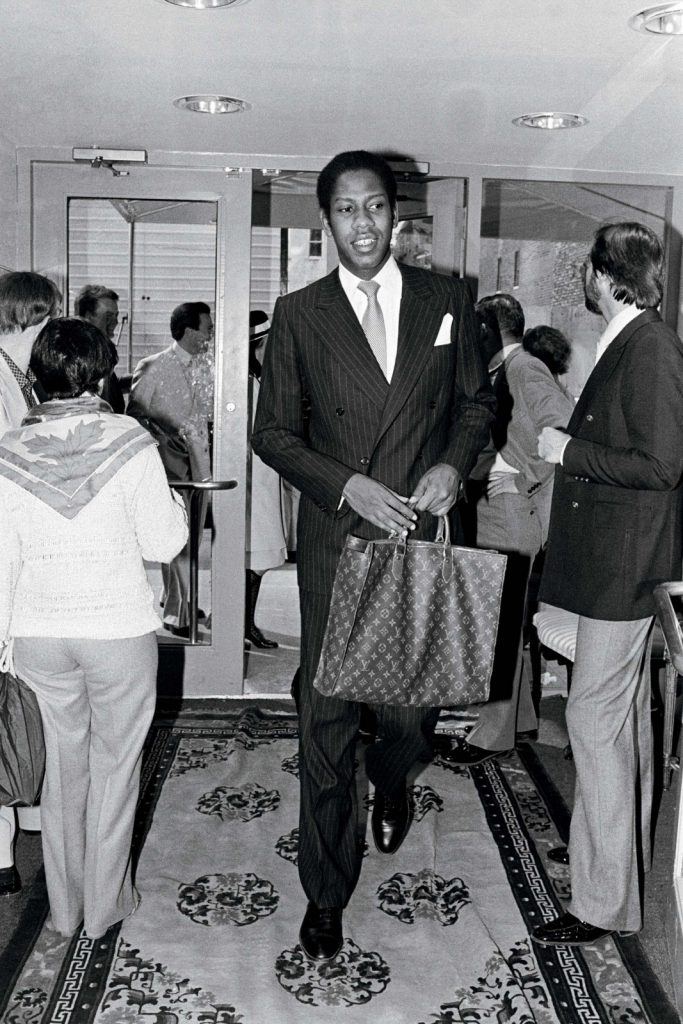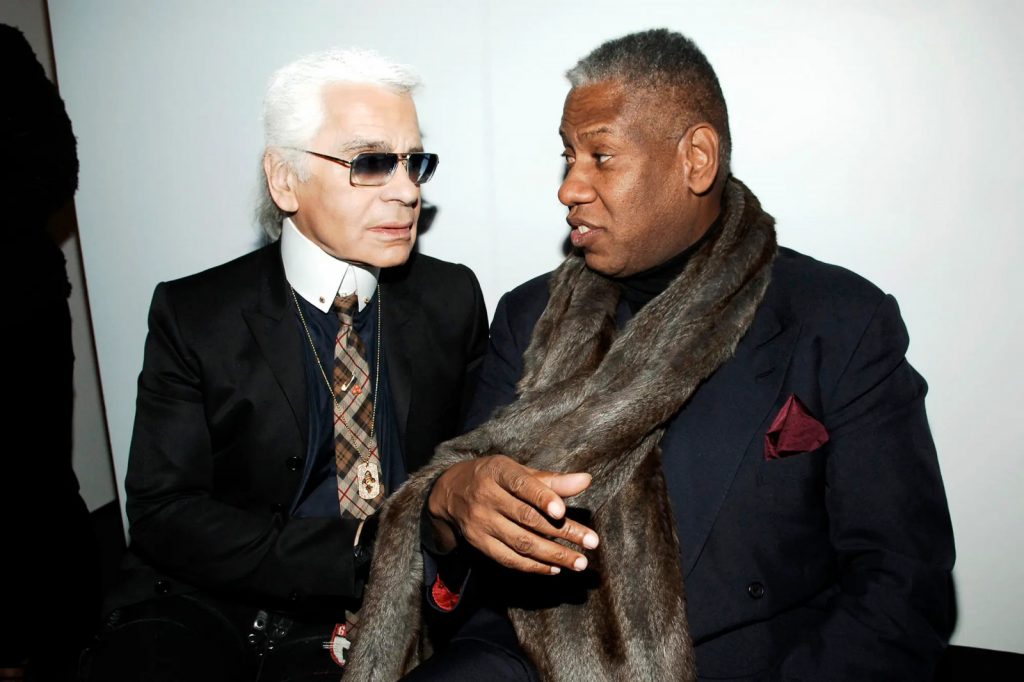Andre-leon-talley-vogue-may-2018: Andre Leon Talley wearing custom Tom Ford Caftan by Jonothan Becker
A year after his death on 18 January 2021 at the age of 73, André Leon Talley, remains a force of fashion and style. For years, Talley was the only person of colour in the upper echelons of fashion journalism, but his story of surviving the fashion battlefield has influenced many of fashion’s editorial decisions.
As the first black man to serve as the creative director of Vogue US, after starting his career at Andy Warhol’s Interview Magazine, Talley’s authoritative voice — in which he speaks in poetic staccatos — can still be heard in fashion corridors today.
Come February 2023, a collection of objects from Talley’s estate is up for auction in The Collection of André Leon Talley, at Christie’s auction house. Among Louis Vuitton trunks and Hermès Birkins and Andy Warhol portraits are his custom-made, haute couture caftans. Talley wore his caftans with exceptional joy.
“I researched indigenous dressing in North Africa, courtly dressing, theatrical dressing and capes. This sense of sartorial style was my inspiration to assemble a wardrobe of caftans,” writes Talley in his 2020 memoir, The Chiffon Trenches.
His caftan collection includes gold brocade caftan by Dapper Dan, a Chanel cape by Karl Lagerfeld and a royal blue and pink silk kimono by Tom Ford, which he wore in his portrait by Jonathan Becker.
Wearing a black caftan is one thing, but wearing a black silk velvet, evening caftan by Ralph Rucci reflects a social life afforded to Talley when glamorous fashion editors were paid exorbitant salaries and publications had huge budgets.
Talley showed the world that you can love clothes and still be a serious person; you can be imperfect and fabulous.
 Andre-Leon-Talley-Alice-Springs: André Leon Talley, ‘La Villa Vigie’ by Alice Springs in 1989.
Andre-Leon-Talley-Alice-Springs: André Leon Talley, ‘La Villa Vigie’ by Alice Springs in 1989.
Rejoice in black joy
Talley’s childhood in the American South is punctuated with memories of crisp, white sheets washed by his humble yet glamorous grandmother, and influenced by images in Vogue magazine.
The matriarchal, religious home where Talley was raised informs the introduction of Talley’s memoir, which he dedicates to Beyoncé’s 2018 Vogue cover. Handpicked by Beyoncé, the cover is photographed by Tyler Mitchell, the first black man to shoot a Vogue cover.
“That image conjures for me laundry drying in the fresh open air,” Talley writes. “In all its elegance, the sheet symbolises so many black women, in their own confident beauty, who did laundry to survive, to provide for their families, to put food on the table. I find it subtly very black. Basic and black. Black with style.”
Talley celebrates this first in Vogue’s 125 year history: “We rejoice in Beyoncé and her blackness, in Tyler Mitchell and his blackness, and in all the generations behind them. I feel unspeakable joy for their landmark in history and for the future of fashion.”
Despite publishing an op-ed in The Washington Post on the significance of Beyoncé’s cover, and sending it to every Condé Nast editor, not one wrote to Talley about it, not even Vogue US editor-in-chief Anna Wintour, who Talley has a close professional and personal relationship with.
“Editors I’ve worked with for decades didn’t understand the immense importance of this occasion simply because they are not capable of understanding. None of my contemporaries have seen the world through black eyes,” recalls Talley.
Talley’s eye for extravagance is infused by the pageantry of church-going in North Carolina, his grandmother’s pursuit for the best she could afford, and reading Vogue, which wallpapered his room.
Gospel according to André
As a part of Andy Warhol’s entourage at Interview magazine, Talley is afforded entry into the best parties, creative circles and interviews with the top echelons where the worlds of art and fashion collide. Talley’s entrance into the highest ranks of fashion comes after his first meeting with designer Karl Lagerfeld in May 1975 for Interview magazine.
Talley’s career is credited to his knowledge, manners and homework, a message that is consistent in his memoir and the 2017 documentary, The Gospel According to André, (bring tissues with you when you watch the film).
“The only reason [Karl Lagerfeld and I] became friends was because I did my homework and research, which is very vital in anything in life,” Talley said in his 2013 address at Oxford University.
Talley’s relationships with the high rollers and social-doers of fashion and high society is something out of a fairytale: lunches with Yves Saint Laurent, attending Paloma Picasso’s wedding, weekends at Lagerfeld’s chateaus and wild nights of partying with Bianca Jagger at Studio 54.
“I wore a silver asbestos fireman’s jacket as an evening topcoat as I jotted down the names of all the various people going into a party. I recognised almost everyone; that’s the kind of knowledge I’d gained from reading every issue of Vogue since I was a child,” writes Talley in The Chiffon Trenches. “I soon made it from the sidewalk to the sitting rooms of the plush homes of the fashion elite as they began inviting me into their parties.”
 Andre-leon-talley-lagerfeld: André Leon Talley with Chanel designer and close friend, Karl Lagerfeld
Andre-leon-talley-lagerfeld: André Leon Talley with Chanel designer and close friend, Karl Lagerfeld
Scarlett ’n the Hood
What is noticeable to those who study Talley’s editorials and creative direction is that it is almost wiped from the pages of Vogue in a way that differs from other fashion media alumni like Grace Coddington, Polly Mellen and Tonne Goodman. A lot of his work is detailed and meticulous, which turned fashion’s narrative on its head, and made people look at race when the topic of race in fashion was ignored.
A 1996 Vanity Fair editorial styled by Talley and shot by Lagerfeld reimagines Gone With the Wind by casting Naomi Campbell as Scarlett O’Hara and white, male fashion heavyweights as her servants, titled Scarlett ‘N The Hood. Givenchy designer John Galliano is pictured mopping floors and Manolo Blahnik (the Bernini of shoes) poses barefoot as a gardener. At Lagerfeld’s home in Paris, Campbell as Scarlett O’Hara saunters down the grand staircase in strapless haute couture dress from John Galliano’s debut 1996 couture collection.
“Pushing back in such a subversive way felt bold and daring. Again, it was a quiet form of activism. My way of approaching diversity in the world of fashion was to communicate with the power of suggestion,” Talley writes. “I never demanded representation and diversity of models; I finessed.”
Talley’s writings of the fashion industry are beautiful, sincere and sharp-witted, even when the fashion industry is not the kindest to him. He is the master of descriptions written with sincere bravado that is fantastic and bombastic, and infused with his larger than life personality. Talley describes clothing as if he has worn them himself.
As the legacies of Talley’s contemporaries like Lagerfeld and Saint Laurent are continued, so should Talley’s who was “a fashion addict, dramatic in attire and appearance”.
 André Leon Talley and Naomi Campbell at the MET Ball 2006
André Leon Talley and Naomi Campbell at the MET Ball 2006